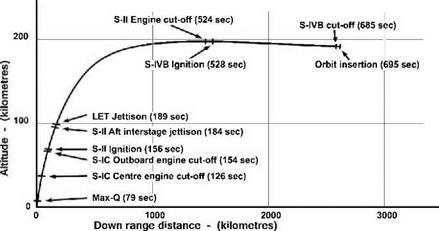Higher and higher: max-Q
 At an altitude of about eight kilometres, the Saturn V attained the speed of sound, or Mach 1, and went supersonic. It was approaching a dangerous region of the ascent. As the stack rose, the density of the air around it gradually diminished, yet as the rocket gained speed, it continued to ram air onto its forwardfacing surfaces, thereby raising the aerodynamic pressure, especially at the conical sections, and increasing the stresses on the skin. At about 14 kilometres, this dynamic pressure, known as ‘Q’, reached its greatest extent, a point in the flight called hnax-Q’. Beyond this point, the rapidly thinning air reduced these aerodynamic stresses.
At an altitude of about eight kilometres, the Saturn V attained the speed of sound, or Mach 1, and went supersonic. It was approaching a dangerous region of the ascent. As the stack rose, the density of the air around it gradually diminished, yet as the rocket gained speed, it continued to ram air onto its forwardfacing surfaces, thereby raising the aerodynamic pressure, especially at the conical sections, and increasing the stresses on the skin. At about 14 kilometres, this dynamic pressure, known as ‘Q’, reached its greatest extent, a point in the flight called hnax-Q’. Beyond this point, the rapidly thinning air reduced these aerodynamic stresses.
|
Graph of planned ascent profile for Apollo 8. (Redrawn from NASA source.) |
This was considered to be a risky phase of the launch and one that was always annunciated by the public affairs commentator in view of the risks it held, when any weakness in the structure would be revealed or when a slight deviation of the great length of the rocket in its true passage through the air at Mach 1.7 could result in the catastrophic break-up of the vehicle.











